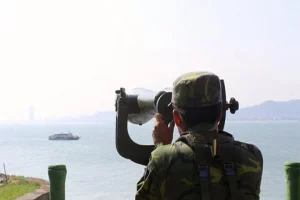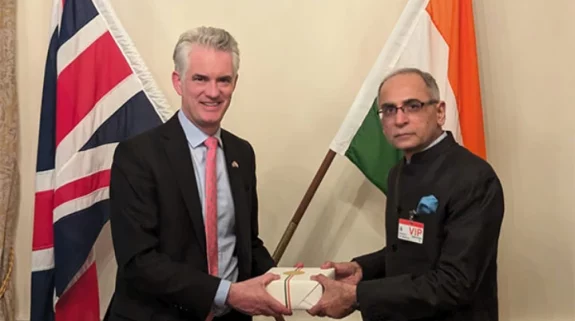India has designated Tso Kar Wetland Complex in Ladakh as its 42nd Wetland of International Importance (Ramsar Site). The site, second in the newly-former Union Territory and 2443rd on the List of Wetlands of International Importance, is found at more than 4,500 metres above sea level in the Changthang region of Ladakh.
The complex includes two connected lakes, the freshwater Startsapuk Tso, a freshwater lake of about 438 hectares to the south, and Tso Kar, a hypersaline lake of 1800 hectares to the north, situated in the Changthang region of Ladakh. It presents a notable example of two such lakes existing in close proximity. The name Tso Kar refers to the white salt efflorescence on the margins of the lake caused by the evaporation of the saline waters. The local climate is arid, and glacial meltwater is the primary water source for the lakes.
The lakes and in particular the presence of fresh water attract biodiversity in a biologically sparse region. Inhabiting the Site are numerous threatened species including the endangered saker falcon (Falco cherrug) and Asiatic wild dog or dhole (Cuon alpinus laniger), and the vulnerable snow leopard (Panthera uncia).
The Tso Kar Basin is an A1 Category Important Bird Area (IBA) as per Bird Life International and a key staging site in the Central Asian Flyway. It acts as an important stopover ground for migratory birds along the Central Asian Flyway and is one of the most important breeding areas in India for the black-necked crane (Grus nigricollis).
This IBA is also the major breeding area for Great Crested Grebe (Podicepscristatus), Bar-headed Geese (Anserindicus), Ruddy Shelduck (Tadornaferruginea), Brown-headed Gull (Larusbrunnicephalus), Lesser Sand-Plover (Charadriusmongolus) and many other species.
The Convention on Wetlands is the inter-governmental treaty that provides the framework for the conservation and wise use of wetlands and their resources.
<blockquote class="twitter-tweet">
<p dir="ltr" lang="en">Happy to share that high-altitude wetland complex in Changthang region of <a href="https://twitter.com/hashtag/Ladakh?src=hash&ref_src=twsrc%5Etfw">#Ladakh</a> is recognized as wetland of international importance. The complex is a notable example of two connected lakes, the freshwater Startsapuk Tso & the hypersaline Tso Kar.
Now, India has 42 Ramsar sites <a href="https://t.co/FMGAKxjqof">pic.twitter.com/FMGAKxjqof</a></p>
— Prakash Javadekar (@PrakashJavdekar) <a href="https://twitter.com/PrakashJavdekar/status/1341979097447067649?ref_src=twsrc%5Etfw">December 24, 2020</a></blockquote>
<script async src="https://platform.twitter.com/widgets.js" charset="utf-8"></script>
The Convention was adopted in the Iranian city of Ramsar in 1971 and came into force in 1975. Since then, almost 90 per cent of UN member states, from all the world’s geographic regions, have acceded to become “Contracting Parties”.
At the time of joining the Convention, each Contracting Party must designate at least one wetland site within their territory for inclusion in the List of Wetlands of International Importance (the Ramsar List).
These Ramsar Sites acquire a new national and international status. They are recognized as being of significant value not only for the country or the countries in which they are located, but for humanity as a whole.
There are currently over 2,400 Ramsar Sites around the world. They cover over 2.5 million square kilometres, an area larger than Mexico.
Parties continue to designate wetlands for inclusion in the List. They select suitable wetlands for designation by referring to the Criteria for identifying Wetlands of International Importance.
The Convention has provided guidance to Contracting Parties on the management of Ramsar Sites, in addition to its guidance on the wise use of all wetlands.
The inclusion of a wetland in the List embodies the government’s commitment to take the steps necessary to ensure that its ecological character is maintained. The Convention includes various measures to respond to threats to the ecological character of Sites.
The aim of the Ramsar list is “to develop and maintain an international network of wetlands which are important for the conservation of global biological diversity and for sustaining human life through the maintenance of their ecosystem components, processes and benefits”.
Wetlands provide a wide range of important resources and ecosystem services such as food, water, fibre, groundwater recharge, water purification, flood moderation, erosion control and climate regulation. They are, in fact, a major source of water and main supply of fresh water comes from an array of wetlands which help soak rainfall and recharge groundwater.
The Ministry of Environment, Forest & Climate Change said it would be working closely with the UT Wetland Authority to ensure wise use of this site..




















